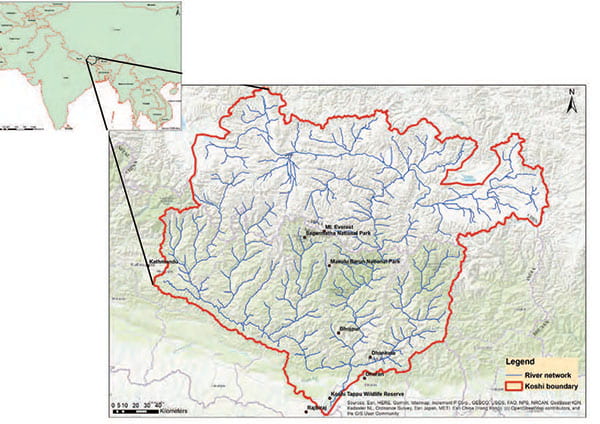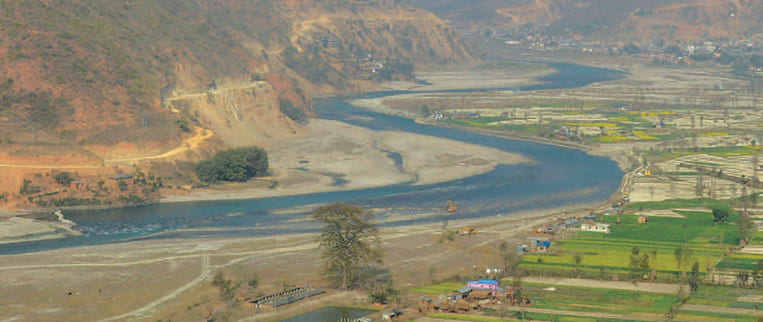Rivers and their associated floodplains are recognised among the world’s most valuable landscapes in terms of ecosystem services
— Sagar Bajracharya, HDR Candidate, Geography and Planning, School of Humanities, Arts and Social Sciences
Ecosystem services are the benefits people gain from the environment. These benefits can be separated into ‘supporting services’ (e.g., biogeochemical cycling, biodiversity, habitat etc.), ‘regulating services’ (e.g., biological processes, climate regulation, regulation of water quality etc.), ‘provisioning services’ (e.g., direct or indirect food for humans, freshwater, power generation etc.), and ‘cultural services’ (e.g., aesthetic, educational, recreational etc.). Monetary values have been assigned to these services to illustrate the importance of environments to society. For example, rivers and their associated floodplains are recognised among the world’s most valuable landscapes in terms of ecosystem services providing more than US$25,681 per ha of economic value to society. Ecosystem services directly link the natural environment to human society. Mr Bajracharya’s PhD research seeks to unpack the relationship between ecosystem services and rivers in Nepal, especially those that will be significantly impacted by climate change.
The Hindu-Kush Himalayan region is commonly referred to as the Third Pole and the water towers of Asia. It contains the most significant amount of frozen water outside of the polar regions. It is the catchment or headwaters of 10 major rivers that collectively provide fresh drinking water, hydropower and irrigation for 1.3 billion people, or 20% of the world’s population. Climate change will have a significant impact on the water resources of The Hindu-Kush Himalayas and the ecosystem services provided by the major river systems of the region.
The Koshi River Basin is the main river system of the greater Himalayan region and one of the most complex of Himalayan river basins in Nepal. It is home to more than 40 million people, many of whom are dependent on the ecosystem services of the riverine landscape of the Koshi. The basin is also home to sensitive and crucial ecosystems, with protected areas that support a high level of biodiversity – it is a hot spot of ecosystem services and functions as a vital corridor for various fauna.

Geographic location map of the Koshi Basin riverine network (Nepal)
Climate change and its impact on ecosystem services are one of the primary global concerns and challenges for the 21st century. It will impact both developed countries like Australia and emerging countries like Nepal. Lessons can be learnt from both. Mr Bajracharya’s PhD will take lessons learnt from the Murray Darling Basin, Australia, and apply them to the Koshi Basin, Nepal.
The Koshi Basin is already witnessing the impact of climate change. The seasonal pattern of monsoon rainfall and periods of floods and droughts are changing—thus changing water availability in terms of the quantity and timing of water resources. The influence of changing flow regimes of the Koshi Basin is crucial because the flow is the master variable that shapes the structure and function of rivers and the ecosystem services they provide for human wellbeing and livelihoods. Given the importance of river ecosystem services to communities in the Koshi Basin, there is an urgent need to understand the influence of climate change on the distribution of ecosystem services of the Koshi basin.
Mr Bajracharya’s PhD research is unpacking links between the physical structure of the Koshi Basin riverine landscape, and the ecosystem services provided by these, and the potential impact of climate change on these relationships. In doing so, this study fills significant knowledge gaps in our understanding of the impact of climate change (water availability) on riverine ecosystem goods and services in the Himalayas. Besides, the knowledge generated will help build effective measures to conserve, protect, restore, manage and utilise riverine ecosystem services in the Koshi basin soon. It is determining the hot spots of ecosystem services along the rivers of the Koshi Basin and determining those likely to be impacted, or not, from climate change.


